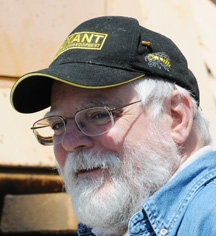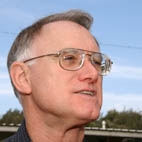Posts Tagged: Susan Cobey
Bee-ing green
Going green in your backyard doesn’t mean just planting a bee-friendly garden and providing water for the bees.
Have you ever thought about becoming a backyard beekeeper? You can help boost the declining bee population while engaging in a fascinating and rewarding hobby. Your flowers, fruits and vegetables will benefit (as will your neighbors' gardens). Another reward that’s sweet: honey.
There’s another benefit, too. If you’re into photography, especially macro photography, this is a perfect opportunity to “bee” there.
The number of backyard beekeepers in the United States has increased by about 15 percent over the last three years, according to Kim Flottum (top), editor of Bee Culture magazine and author of The BackYard Beekeeper: An Absolute Beginner’s Guide to Keeping Bees in Your Yard and Garden. He estimates the number at 100,000-plus and growing.
“Backyard beekeepers easily represent more than 80 percent of total beekeepers, but have only about 25 percent of the total hives,” he told us. “They contribute lots to local pollination of small gardens and orchards and plants for wildlife. And, they are responsible for most of the local honey one sees for sale, since most sell close to home in farmers’ markets and the like.”
Extension apiculturist Eric Mussen (left), member of the UC Davis Department of Entomology faculty, also advocates that folks do their part in the honey bees crisis. Don’t just plant bee friendly plants, but plants that bees can forage on in the late summer and fall when food is scarce, he says.
The Xerces Society for Invertebrate Conservation provides regional lists of bee friendly plants. The UC Berkeley Urban Gardens website maintains a California list.
What are some of the first steps in becoming a beekeeper?
- Join a local beekeeping association where veterans can assist you. Bee Culture maintains contact information for beekeeping associations. The Harry H. Laidlaw Jr. Honey Bee Research Facility at UC Davis maintains a list of beekeeping clubs in California. Many 4-H clubs also offer beekeeping projects where youths can learn the not-so-secret life of bees.
- Check your city and county ordinances and your county agriculture commissioner for bee-colony regulations.
- Contact your neighbors to see if they are allergic to bee stings or if they have any objections to your keeping bees.
- Start a library of beekeeping books. Some of the most recent books by bee experts include The Backyard Beekeeper by Kim Flottum; Honey Bee Hobbyist: the Care and Keeping of Bees by UC Davis retired emeritus professor Norman Gary (his experience spans six decades); and Storey's Guide to Keeping Honey Bees: Honey Production, Pollination and Health by University of Florida Extension beekeeping specialist Malcolm T. Sanford, with expertise from the late Richard E. Bonney's book, Beekeeping and Hive Management.
- Subscribe to bee publications such as The American Bee Journal, Bee Culture and Speedy Bee.
- Glean information from the Internet, including YouTube, but be aware that some info is misleading and inaccurate.
Bee breeder-geneticist Susan Cobey of UC Davis and Washington State University cautions that you must take care of your bees to ward off diseases and pests. And, if you’re catching swarms, especially in southern California, be aware that some could be Africanized bees.
“The swarms are initially docile, but can become very defensive when they grow and have brood and honey—and turn to a public health issue,” she says.
Cobey advocates that would-be beekeepers find a good mentor and/or bee club that offers beginners’ classes and arranges purchase of good queens.
“Temperament alone will make a huge difference,” she says.
Good advice!
On the light side, once you’re a bonafide beekeeper, you can wear T-shirts like “Show Me the Honey,” “I Have Hives” and “I Smoke Burlap.”
The best part of rearing your very own bees, though, is making an individual statement in a world filled with millions of unanswered questions.
Colony collapse disorder (CCD) is one of them.
(Editor's note: Kathy Keatley Garvey, a communication specialist in the UC Davis Department of Entomology, comes from a long line of beekeepers tracing back to "at least the 1800s.")
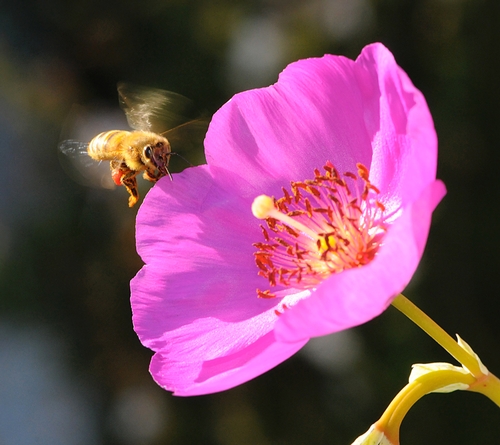
Backyard Bee
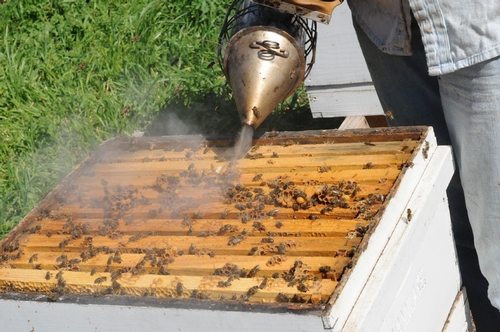
Smoking the Hive
Show me the honey
When the grand opening celebration of the Häagen-Dazs Honey Bee Haven at the University of California, Davis, takes place on Saturday, Sept. 11 from 10 a.m. to 2 p.m., this will also be a celebration of the honey bee.
The declining bee population, exacerbated by the mysterious disease called colony collapse disorder, makes us appreciate bees all the more. One-third of the food we eat is pollinated by bees.
Enter the Häagen-Dazs Honey Bee Haven.
Planted last fall next to the Harry H. Laidlaw Jr. Honey Bee Research Facility on Bee Biology Road, the honey bee haven is a half-acre bee friendly garden designed to provide a year-around food source for bees, increase awareness of the plight of the honey bee, and offer educational experiences for human visitors.
Visitors can learn the importance of honey bees and glean ideas on what to plant in their own gardens to attract bees and other pollinators. Here’s the award-winning design created by a Sausalito team. (Be sure to check out the Häagen-Dazs educational website.)
At the Sept. 11 grand opening, visitors also will gain a deeper appreciation of honey, sometimes called “the soul of a field of flowers.” Honey tasting, coordinated by Extension apiculturist Eric Mussen, member of the UC Davis Department of Entomology, is scheduled to be one of the activities at the celebration.
Of the more than 300 unique types of honey produced in the United States, among the most common floral sources are alfalfa, avocado, basswood, buckwheat, clover, eucalyptus, fireweed, orange blossom, safflower sages and tupelo.
A single bee can collect about 1/2 teaspoon of honey in her lifetime. To make a pound of honey, 560 worker bees must gather nectar from two million flowers, and fly a total of about 55,000 miles.
Like to cook with honey? Here are some recipes provided by the National Honey Board.
Applesauce Cake
1/2 cup butter, softened
1 cup honey
1 egg
1 teaspoon vanilla
1-1/4 cups all-purpose flour
1 cup whole wheat flour
1 teaspoon baking soda
?1 teaspoon ground cinnamon
1/2 teaspoon salt
1/2 teaspoon ground nutmeg
1/4 teaspoon ground cloves
1/4 teaspoon ground allspice or ginger
1 cup chopped dates
1/3 cup chopped walnuts
1 cup unsweetened applesauce
Cream butter in large bowl. Gradually beat in honey until light and fluffy. Add egg and vanilla; mix well. Combine dry ingredients in medium bowl; reserve 2 tablespoons flour mixture. Combine dates, walnuts and reserved 2 tablespoons flour mixture in small bowl; set aside. Add remaining flour mixture and applesauce alternately to creamed mixture, beginning and ending with flour mixture. Stir in date mixture. Pour batter into greased 13 x 9 x 2-inch pan. Bake at 325 degrees F for 35 minutes or until wooden pick inserted near center comes out clean.
Cranberry Oat Bread
3/4 cup honey
1/3 cup vegetable oil
2 eggs
1/2 cup milk
2-1/2 cups all-purpose flour
1 cup quick-cooking rolled oats
1 teaspoon baking soda?
1 teaspoon baking powder
1/2 teaspoon salt
1/2 teaspoon ground cinnamon
2 cups fresh or frozen cranberries
1 cup chopped nuts
Combine honey, oil, eggs and milk in large bowl; mix well. Combine flour, oats, baking soda, baking powder, salt and cinnamon in medium bowl; mix well. Stir into honey mixture. Fold in cranberries and nuts. Spoon into two 8-1/2 x 4-1/2 x 2-1/2-inch greased and floured loaf pans.
Bake in preheated 350 degrees oven 40 to 45 minutes or until wooden toothpick inserted near center comes out clean. Cool in pans on wire racks 15 minutes. Remove from pans; cool completely on wire racks. Makes 2 loaves.
Golden Cornbread
3 cups yellow cornmeal
1 cup whole wheat flour
2 tablespoons baking powder
1 teaspoon salt
2 cups buttermilk or low-fat yogurt
1/2 cup butter, melted
1/2 cup honey
3 eggs, beaten
Combine cornmeal, flour, baking powder and salt in large bowl. Combine buttermilk, butter, honey and eggs in separate large bowl. Stir buttermilk mixture into flour mixture just until moistened. Pour into greased 12x8x2-inch baking pan. Bake at 350 degrees for 25 minutes or until golden brown. Serves 8.

Honey Bee
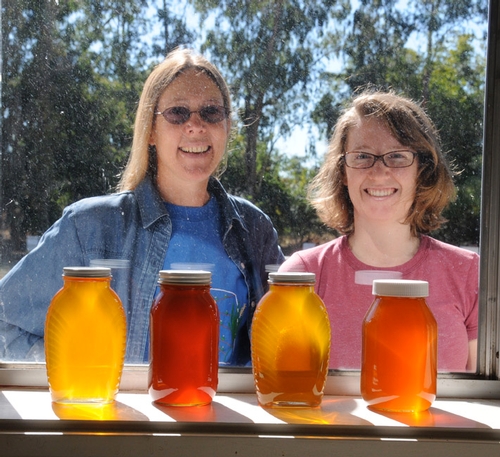
The Beekeepers

